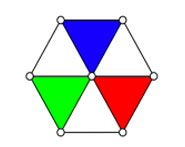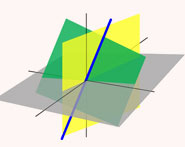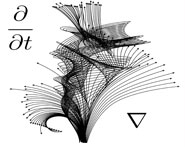


 تاريخ الرياضيات
تاريخ الرياضيات
 الرياضيات في الحضارات المختلفة
الرياضيات في الحضارات المختلفة 
 الرياضيات المتقطعة
الرياضيات المتقطعة
 الجبر
الجبر
 الهندسة
الهندسة 
 المعادلات التفاضلية و التكاملية
المعادلات التفاضلية و التكاملية 
 التحليل
التحليل
 علماء الرياضيات
علماء الرياضيات |
Read More
Date: 30-6-2020
Date: 11-6-2020
Date: 18-1-2021
|

A polygonal number and 6-polygonal number of the form  . The first few are 1, 6, 15, 28, 45, ... (OEIS A000384). The generating function for the hexagonal numbers is given by
. The first few are 1, 6, 15, 28, 45, ... (OEIS A000384). The generating function for the hexagonal numbers is given by
 |
(1) |
Every hexagonal number is a triangular number since
![r(2r-1)=1/2(2r-1)[(2r-1)+1].](https://mathworld.wolfram.com/images/equations/HexagonalNumber/NumberedEquation2.gif) |
(2) |
In 1830, Legendre (1979) proved that every number larger than 1791 is a sum of four hexagonal numbers, and Duke and Schulze-Pillot (1990) improved this to three hexagonal numbers for every sufficiently large integer.
There are exactly 13 positive integers that cannot be represented using four hexagonal numbers, namely 5, 10, 11, 20, 25, 26, 38, 39, 54, 65, 70, 114, and 130 (OEIS A007527; Guy 1994a).
Similarly, there are only two positive integers that cannot be represented using five hexagonal numbers, namely:
 |
 |
 |
(3) |
 |
 |
 |
(4) |
Every positive integer can be represented using six hexagonal numbers.
REFERENCES:
Duke, W. and Schulze-Pillot, R. "Representations of Integers by Positive Ternary Quadratic Forms and Equidistribution of Lattice Points on Ellipsoids." Invent. Math. 99, 49-57, 1990.
Guy, R. K. "Every Number Is Expressible as the Sum of How Many Polygonal Numbers?." Amer. Math. Monthly 101, 169-172, 1994a.
Guy, R. K. "Sums of Squares." §C20 in Unsolved Problems in Number Theory, 2nd ed. New York: Springer-Verlag, pp. 136-138, 1994b.
Legendre, A.-M. Théorie des nombres, 4th ed., 2 vols. Paris: A. Blanchard, 1979.
Sloane, N. J. A. Sequences A000384/M4108 and A007527/M3739 in "The On-Line Encyclopedia of Integer Sequences."



|
|
|
|
التوتر والسرطان.. علماء يحذرون من "صلة خطيرة"
|
|
|
|
|
|
|
مرآة السيارة: مدى دقة عكسها للصورة الصحيحة
|
|
|
|
|
|
|
نحو شراكة وطنية متكاملة.. الأمين العام للعتبة الحسينية يبحث مع وكيل وزارة الخارجية آفاق التعاون المؤسسي
|
|
|